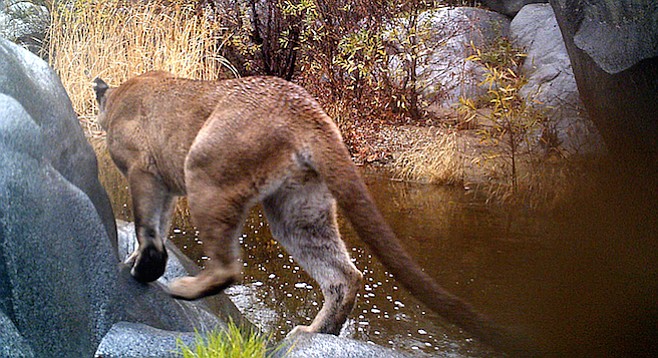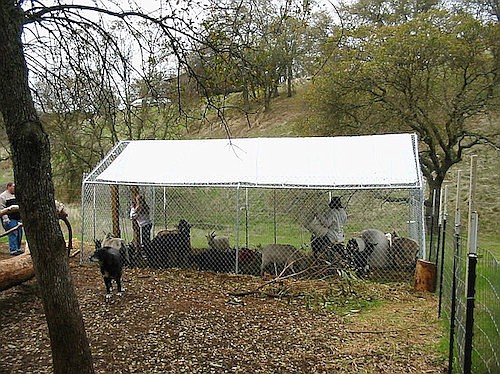 Facebook
Facebook
 X
X
 Instagram
Instagram
 TikTok
TikTok
 Youtube
Youtube

On Saturday, June 11, mountain-lion conservationists will join the Santa Ysabel and Julian 4-H Club to build a lightweight and inexpensive pen designed to protect goats, sheep, pigs, and other domestic animals from mountain lions. Keeping livestock enclosed in a safe barn or pen from dusk to dawn is the best protection from wildlife conflicts.
The Mountain Lion Foundation points to the town of Julian as a hot spot for losses of livestock and mountain lions alike.
"The vast majority of domestic animals killed by lions in Julian are kept on very small acreages associated with a home or cabin, not part of a large ranching operation," said foundation director Lynn Cullens. "We're hopeful that the expertise of the local 4-H Club will lead the way to model the best deterrents so that Julian residents can enjoy livestock and pets without creating attractants to mountain lions."
Dr. Winston Vickers, principal investigator for the University of California Wildlife Health Center's Southern California Puma Project, says, “When you add the ongoing loss and fragmentation of habitat by development and increasing wildfire frequency to the negative effects of genetic restriction and high mortality rates, it is easy to see why we feel that some local mountain-lion populations could be facing too many challenges to persist long-term. We are in the process of working with other collaborators to define how severe that risk is.”
The study has analyzed the more than 257 mountain lion deaths in the region over the past 30 years that were reported to the California Department of Fish and Wildlife. In addition, the Southern California Puma Project collected data from 93 lions captured more than 150 times and fitted with GPS collars.These collared lions have shown that in the Santa Ana Mountain Range west of I-15, the majority of lion deaths are due to collisions with cars. But in the mountains of San Diego County, lions die most frequently when they prey on unprotected domestic animals and are subsequently killed on state-issued depredation permits. Other lions are illegally killed for trophies or unknown reasons.
Jane Santorumn, the local volunteer who established the Julian Mountain Lion Project early this year, points out that "some of our neighbors have regretted requesting a permit once we let them know that lions are killed rather than relocated. Others have expressed surprise that our local mountain-lion population may not survive the next few decades without human help and are motivated to take steps to avoid future conflicts."
Since January, Santorumn and other volunteers have teamed up with the 4-H Club, the Mountain Lion Foundation, University of California Wildlife Health Center, the UC Extension Service, Wildlife Research Institute, and other organizations and agencies to conduct a long-term conservation program in the Julian area. The goal is to resolve conflicts and save lions.
The five-year project begins with an effort to learn from those families who have already experienced lion problems in small livestock situations. The collaboration is intended to generate ideas to reduce the increasing number of avoidable livestock and mountain-lion deaths. The pen to be constructed June 11 will be on a property where lions have killed domestic animals twice this year. The two mountain lions were killed as a result.

During the pen construction Fauna Tomlinson — one of the nation's most well-informed experts on new technologies designed to deter wildlife — will demonstrate some of the newest designs for frightening deer, foxes, coyotes, bobcats, mountain lions, and other wild animals away from rural properties. Local contractors will be on hand to learn to provide services and products for animal owners who would like to have a pen and frightening devices but who would prefer not to build their own.
Julian’s landscape features and the obstacles of roads and human occupation tend to direct mountain lions repeatedly through particular rural neighborhoods. Gardens, vineyards, and orchards attract deer, the lions' preferred prey. For all these reasons, mountain lions are spotted more often than in decades past. There seem to be more lions than there actually are.
The territory of a male mountain lion commonly spans 200 square miles. Conserved lands in Southern California mountain ranges tend to be scattered, unconnected, and small relative to the land required by lions. This forces the few big cats across busy roads and through narrow corridors heavily used by people and their pets.
Research by Vickers and other scientists suggests that the Southern California mountain-lion population may be declining. The researchers have tested DNA, studied disease, and accounted for mortality due to human interaction. They have followed mountain-lion movements throughout mountain ranges in Orange, San Diego, and Riverside counties.
The genetic diversity, health, and viability of the breeding populations of mountain lions in Southern California is very low relative to lions in other western states. Vickers’s research shows that a potentially dangerous level of inbreeding may be due in part to the tendency for depredation permits in San Diego County to be issued for male lions.
Young males are critical to the genetic health of the entire population because they spread their genes broadly when dispersing to find a territory. Killing older and well-established males can also be counterproductive if young males crowd in and compete for the vacant territory. Lion populations dominated by young males may actually increase the chances of another depredation event in the near-term.
"While habitat conservation and corridor protection are critical to mountain lion survival," says Cullens of the Mountain Lion Foundation, "protecting people and domestic animals is also essential to ensure long-term mountain lion survival." The Wildlife Health Center (http://www.vetmed.ucdavis.edu/whc/programs/california-conservation/mountain-lions.cfm) advises that "Avoiding backcountry trails after twilight, protecting pets and livestock from potential attacks and learning to see the world through the eyes of wildlife are some basic safety tips."
The author is managing director of the Wildlife Research Institute, Inc. This (edited) article was first published in Wild News and sent to members of the Julian-based nonprofit.


On Saturday, June 11, mountain-lion conservationists will join the Santa Ysabel and Julian 4-H Club to build a lightweight and inexpensive pen designed to protect goats, sheep, pigs, and other domestic animals from mountain lions. Keeping livestock enclosed in a safe barn or pen from dusk to dawn is the best protection from wildlife conflicts.
The Mountain Lion Foundation points to the town of Julian as a hot spot for losses of livestock and mountain lions alike.
"The vast majority of domestic animals killed by lions in Julian are kept on very small acreages associated with a home or cabin, not part of a large ranching operation," said foundation director Lynn Cullens. "We're hopeful that the expertise of the local 4-H Club will lead the way to model the best deterrents so that Julian residents can enjoy livestock and pets without creating attractants to mountain lions."
Dr. Winston Vickers, principal investigator for the University of California Wildlife Health Center's Southern California Puma Project, says, “When you add the ongoing loss and fragmentation of habitat by development and increasing wildfire frequency to the negative effects of genetic restriction and high mortality rates, it is easy to see why we feel that some local mountain-lion populations could be facing too many challenges to persist long-term. We are in the process of working with other collaborators to define how severe that risk is.”
The study has analyzed the more than 257 mountain lion deaths in the region over the past 30 years that were reported to the California Department of Fish and Wildlife. In addition, the Southern California Puma Project collected data from 93 lions captured more than 150 times and fitted with GPS collars.These collared lions have shown that in the Santa Ana Mountain Range west of I-15, the majority of lion deaths are due to collisions with cars. But in the mountains of San Diego County, lions die most frequently when they prey on unprotected domestic animals and are subsequently killed on state-issued depredation permits. Other lions are illegally killed for trophies or unknown reasons.
Jane Santorumn, the local volunteer who established the Julian Mountain Lion Project early this year, points out that "some of our neighbors have regretted requesting a permit once we let them know that lions are killed rather than relocated. Others have expressed surprise that our local mountain-lion population may not survive the next few decades without human help and are motivated to take steps to avoid future conflicts."
Since January, Santorumn and other volunteers have teamed up with the 4-H Club, the Mountain Lion Foundation, University of California Wildlife Health Center, the UC Extension Service, Wildlife Research Institute, and other organizations and agencies to conduct a long-term conservation program in the Julian area. The goal is to resolve conflicts and save lions.
The five-year project begins with an effort to learn from those families who have already experienced lion problems in small livestock situations. The collaboration is intended to generate ideas to reduce the increasing number of avoidable livestock and mountain-lion deaths. The pen to be constructed June 11 will be on a property where lions have killed domestic animals twice this year. The two mountain lions were killed as a result.

During the pen construction Fauna Tomlinson — one of the nation's most well-informed experts on new technologies designed to deter wildlife — will demonstrate some of the newest designs for frightening deer, foxes, coyotes, bobcats, mountain lions, and other wild animals away from rural properties. Local contractors will be on hand to learn to provide services and products for animal owners who would like to have a pen and frightening devices but who would prefer not to build their own.
Julian’s landscape features and the obstacles of roads and human occupation tend to direct mountain lions repeatedly through particular rural neighborhoods. Gardens, vineyards, and orchards attract deer, the lions' preferred prey. For all these reasons, mountain lions are spotted more often than in decades past. There seem to be more lions than there actually are.
The territory of a male mountain lion commonly spans 200 square miles. Conserved lands in Southern California mountain ranges tend to be scattered, unconnected, and small relative to the land required by lions. This forces the few big cats across busy roads and through narrow corridors heavily used by people and their pets.
Research by Vickers and other scientists suggests that the Southern California mountain-lion population may be declining. The researchers have tested DNA, studied disease, and accounted for mortality due to human interaction. They have followed mountain-lion movements throughout mountain ranges in Orange, San Diego, and Riverside counties.
The genetic diversity, health, and viability of the breeding populations of mountain lions in Southern California is very low relative to lions in other western states. Vickers’s research shows that a potentially dangerous level of inbreeding may be due in part to the tendency for depredation permits in San Diego County to be issued for male lions.
Young males are critical to the genetic health of the entire population because they spread their genes broadly when dispersing to find a territory. Killing older and well-established males can also be counterproductive if young males crowd in and compete for the vacant territory. Lion populations dominated by young males may actually increase the chances of another depredation event in the near-term.
"While habitat conservation and corridor protection are critical to mountain lion survival," says Cullens of the Mountain Lion Foundation, "protecting people and domestic animals is also essential to ensure long-term mountain lion survival." The Wildlife Health Center (http://www.vetmed.ucdavis.edu/whc/programs/california-conservation/mountain-lions.cfm) advises that "Avoiding backcountry trails after twilight, protecting pets and livestock from potential attacks and learning to see the world through the eyes of wildlife are some basic safety tips."
The author is managing director of the Wildlife Research Institute, Inc. This (edited) article was first published in Wild News and sent to members of the Julian-based nonprofit.
Comments